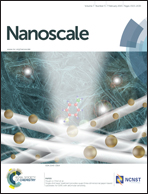Single-shot laser treatment provides quasi-three-dimensional paper-based substrates for SERS with attomolar sensitivity†
Abstract
In this study, an eco-friendly and ultrasensitive paper substrate is developed for surface-enhanced Raman scattering (SERS) with performance approaching single molecule detection. By exploiting the laser-induced photothermal effect, paper fibrils with hybrid micro- and nanostructures can facilitate the formation of highly dense metal nanoparticles (NPs) after a single shot of laser illumination. Metal films deposited on the paper substrates feature discontinuous morphologies, with the fragments acting as multiple nucleation sites. Because thermal conductivity is low on the broken films and the underlying paper fibrils, the incident energy is absorbed efficiently. Moreover, the quasi-three-dimensional distribution of NPs on the SERS paper greatly enhances the SERS signals within the effective collection volume of a Raman microscope. As a result of the large number of highly effective hot spots and the condensation effect, the hydrophobic SERS paper provides SERS signals with stable and uniform reproducibility throughout the detection area. The limits of detection when using the paper substrates reach the attomolar (10−18 M) level, thereby approaching single molecule detection.


 Please wait while we load your content...
Please wait while we load your content...